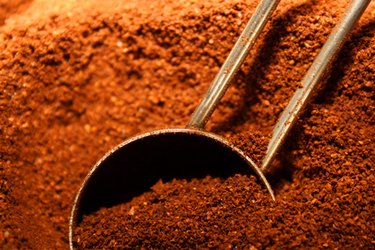
Coffee grounds are good for grass when you use them as mulches or soil amendments, but you can also use coffee grounds to prevent weeds and help certain plants thrive. Coffee grounds are great for garden use because they don't cost you anything if you brew your coffee at home, and the grounds are non-toxic and environmentally friendly.
Coffee Grounds on the Lawn
Video of the Day
Coffee grounds contain nitrogen-rich proteins, and after the liquid is brewed, the leftover grounds contain beneficial lipids, oils, fatty acids, triglycerides, cellulose and other insoluble carbohydrates. When the grounds are spread out on top of the ground, fungi and bacteria break down those chemicals. Hungry earthworms and other ground dwellers pull the grounds into the soil, which improves soil structure. Coffee ground degradation also produces humic substances that provide soil and plant nutrition.
Video of the Day
When used as soil amendments and mulches, coffee grounds increase soil water, moderate soil temperature, and bind heavy metals like cadmium and pesticide residues. That binding action prevents them from spreading. To feed your lawn with coffee grounds, scatter it over the grass and sweep or rake it out lightly; you don't want deep piles of it sitting on the grass. Another potential distribution method involves putting it into a holed bucket or using a spreader. If you don't have enough coffee grounds to fill that bucket, ask at your local coffee shop. Even shops that normally throw them away are often happy to recycle them.
Coffee as a Weed Suppressant
Fresh coffee grounds can also help control weeds. This weed suppressant nature is because the grounds are thought to be allelopathic. An allelopathic substance produces biochemicals that affect the germination and growth of other organisms. They suppress specific fungal pathogens, too. Coffee grounds have not been shown to repel garden pests such as insects, but cats, rabbits and other creatures may be turned away.
Avoid using coffee grounds where plants are being grown from seed, as this could lead to reduced germination and plant growth. You can work them in as a soil amendment, and many gardeners put them in their compost. However, you may sprinkle fresh grounds around certain acid-loving plants like lilies (Syringa spp.; USDA growing zones 3-8), blueberries (Vaccinium spp.; USDA growing zones 5-10), hydrangeas (Hydrangea spp.; USDA growing zones 3-8) and azaleas (Rhododendron spp.; USDA growing zones 5-9).
Many vegetable plants like slightly acidic soil, but tomatoes (Solanum lycopersicum; USDA growing zones 2-10) will most likely not appreciate it. As a guideline, you can use the fresh grounds when planting root crops like carrots (Daucus carota; USDA growing zone 3-10) and radishes (Raphanus sativus; USDA growing zones 2-11).
Composting With Coffee
One of the most effective ways to use coffee grounds is to add them to compost, but they should make up only 10 to 20 percent of the total volume; more than that will have a negative effect on the entire compost pile. Coffee grounds are considered green compost material, so balance them with brown compost material. A good mixture is 1 part coffee grounds to 4 parts of shredded leaves, along with some wood ash or lime to balance the initial acidity.
You want to avoid using the coffee grounds as a thick mulch because they can compact and create a barrier that works to prevent water and air from getting in. When spreading them on grass or soil, apply a thin layer that's no more than half an inch deep.
- Washington State University Extension: Using Coffee Grounds in Gardens and Landscapes
- Burger Farm & Garden Center: Ask Mr. Burger - Can Coffee Grounds Be Used in My Garden and Lawn?
- HGTV: How to Use Coffee Grounds in the Garden
- OOLA: This Is Why Used Coffee Grounds Belong in Your Garden, Not the Trash!